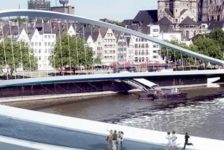Diana Balmori understands the power of visibility.
Her firm, Balmori Associates (which by the way is made up of super talented dedicated designers and amazing design alums), has projects around the globe and is known for highly creative landscapes that urge clients and users to question their idea of a lawn, garden, or park. Whether through 35,000 sq feet of green roofs in Long Island, NY or a stair climbing garden in Bilbao, Spain, Balmori Associates does not let the landscape fall to the background. For some examples, check out their website, http://www.balmori.com/balmoriMain.htm, where projects like the Botanical Research Institute of Texas in Fort Worth, Texas and their proposal for the Highline in NYC show their unflinching dedication to roaring soaring landscapes supported by cultural goals and steeped in ecological realism. Also notice how the firm’s representation style changes for each project, every drawing is its own work of art. The representations coming out of Balmori like dot matrix perspectives and neon-colored felt model are always refreshing to see the competition circuit.
Balmori’s exploratory work raises the over-all visibility of the landscape profession and now Diana Balmori is shooting off landscape fireworks in another venue: through written word.
Previously, Diana Balmori published ‘The Land and Natural Development (LAND) Code, Guidelines for Sustainable Land Development’ and ‘Redesigning the American Lawn’ both works that boldly explore new sustainable ways of living in the United States.
This latest publication , ‘A Landscape Manifesto’, which discusses 25 points meant to raise one’s awareness of non-traditional potentials in landscape architecture is a little different. It’s interactive. A lovely coffee table ice-beaker, the manifesto invites people to open up the book, read a manifesto point, and answer for themselves and each other what exactly is the landscape in this day and age. Along with the written manifesto, a companion website has been launched to connect remote readers. Although in its nascent stage it’s growing in members. Delve into some manifesting here: http://landscapemanifesto.tumblr.com/
If you want to purchase A Landscape Manifesto click here. With her track record for being front stage I’ve no doubt this book will be on a lot of people’s radar.
Diana sat down with Plan and Section to talk about the difference between art+design, social media’s role in contemporary landscape architecture, and the place ‘A Landscape Manifesto’ holds in the profession today.
1. What challenges does ‘A Landscape Manifesto’ address in contemporary landscape architecture?
The challenge for landscape today is the city, to learn to treat it as an integral park of nature. Landscape is the most important new player in cities. And not in a 19-20th century way, like putting parks in it. Rather by questioning its infrastructure; its impermeability; its treatment of creeks and streams in the city. Nor does this mean taking on the city as one whole entity. It may mean making its traffic islands green or creating green roofs or green walls, or making temporary public space. Or taking a road and making a linear park out of it by which you can travel a good part of a city on foot and connecting many new neighborhoods.
2. ‘A Landscape Manifesto’ aims to ‘spark conversations about landscape architecture.’ How has your book tried to include non-designers in this conversation?
By using a simple non-jargon language and striving for clarity.
3. The 25 points in ‘A Manifesto’ are online and invite people to contribute landscapes to the manifesto community. Previously, Balmori Associates combined landscape architecture and social media in a Twitter urban design forum. Please talk about these experiences and Balmori’s interest in landscape architecture and social networking?
I’m interested in getting as broad based and international a conversation as can be had. I’m interested in the electronic media’s way of opening the door to this. I think landscape architecture touches on something everyone wants and has experienced. It is always valuable to hear the voice of users. Electronic media allows us to do it as a stream of info not as a one time meeting at the start of a project.
4. A Landscape Manifesto states ‘landscape architecture is an art that spans the divide between culture and nature’. Do you draw a line between art and design? If so, how does landscape architecture span this divide?
I do think design is art or should be. Landscape architecture is designed and needs to reach a high level of artistic resolution if it wants to receive attention. As to the culture and nature divide we are finally in the stage of overcoming it by understanding that there is no unfiltered Nature; that culture, the filter, is part of the equation.
5. This profession produces beautiful illustrations, ie. sections, plans and perspectives that are put away once the design is built. At Balmori do you consider these illustrations simply as artifacts of the process or as stand-alone works of art?
The illustrations created for presenting the ideas and designs for a project are, as you say, put away. But the images created are important, not to stand on their own as art, but as an artistic communication of intentions, of ideas, of feelings. Sometimes the finished work loses one or another part of this and the illustration stands there to communicate (in a published form) what was imagined.
6. Balmori Associates has a very expressive style in landscape design and in the associated renderings. When creating representations do you as a firm try to match the style of the representation with the mood of the place you’ve designed?
Do we try to match in our renderings the mood of a place? Yes sometimes. In our portrayal of the Botanical Research Institute in Texas (Fort Worth) what we tried was to give a sense of the brilliant light of that part of Texas; a searing light which ratchets up all colors.
Via Plan+Section
Published in Blog









